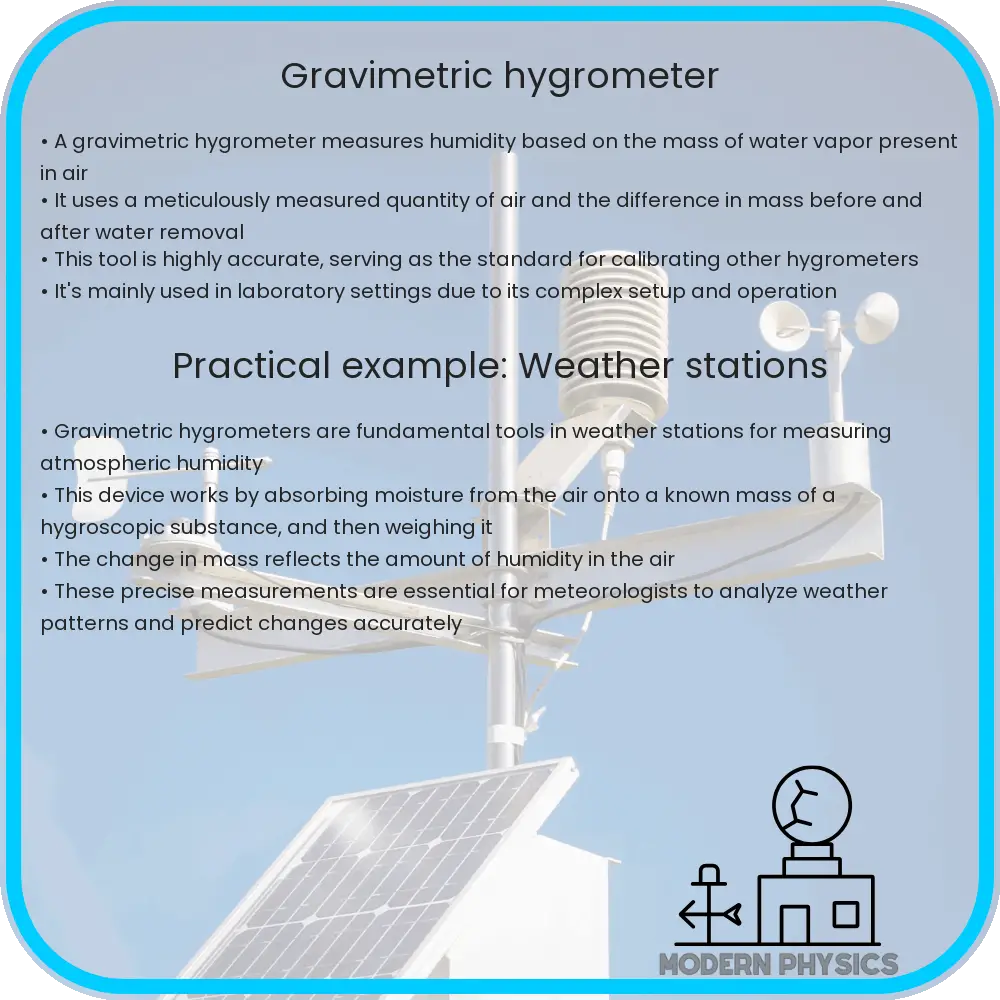Learn about gravimetric hygrometers, precision devices for measuring air moisture by weighing water vapor in a controlled environment.

Understanding Gravimetric Hygrometers
When it comes to measuring humidity levels in the air, there are several types of devices that can be used, each employing a different method and offering varying degrees of accuracy. One such device is the gravimetric hygrometer, which is known for its precision in determining the moisture content of the atmosphere.
How Does a Gravimetric Hygrometer Work?
A gravimetric hygrometer measures the absolute humidity of air by physically weighing the amount of water vapor present in a known volume of air. This method is considered the most direct and reliable measurement of humidity, which makes it a standard against which other types of hygrometers are calibrated.
The process involves drawing a measured volume of air through a drying agent which absorbs water vapor from the air. The increase in weight of the drying agent gives a direct measure of the moisture content in the air. Mathematically, the absolute humidity (AH) in grams of water per cubic meter of air (g/m3) can be calculated using the formula:
AH = (mv / V) * 106, where:
mvis the mass of the water vapor in grams.Vis the volume of air in cubic meters through which the vapor was removed.
This calculation reveals the mass of the water content per unit volume of air, representing the absolute humidity.
Calibration of Gravimetric Hygrometers
Calibration is crucial for maintaining the accuracy of any measuring instrument, and gravimetric hygrometers are no exception. These devices are typically used to calibrate other types of hygrometers. Calibration involves comparing the device under test against the gravimetric hygrometer’s readings and adjusting as necessary to match the reference. This is often carried out in specialized humidity calibration chambers.
Due to the precise nature of the measurements and the need for accurate weight and volume determinations, the calibration of gravimetric hygrometers must be performed with meticulous attention to detail, ensuring no external factors, such as air pressure changes or temperature variations, affect the readings.
Uses of Gravimetric Hygrometers
Gravimetric hygrometers are generally used in scientific research, where detailed and accurate measurement of humidity is crucial. They are also deployed in industrial settings where air moisture levels are critical to manufacturing processes, such as in pharmaceuticals or electronics manufacturing.
Moreover, their application in calibrating other hygrometers makes them an indispensable tool in meteorological stations and laboratories working on climate monitoring and control systems. Their reliability and accuracy ensure that other less precise instruments can deliver useful and consistent data for weather forecasting and atmospheric science.
Advantages and Limitations of Gravimetric Hygrometers
The key advantage of using a gravimetric hygrometer is its high level of accuracy. As it directly measures the mass of water vapor, it is less susceptible to errors compared to other hygrometric methods, such as those based on changes in electrical capacitance or resistance.
However, despite their precision, gravimetric hygrometers also have a few limitations. Their operation is more complex and time-consuming, requiring careful sample handling and preparation. Furthermore, they are generally more expensive and require a controlled laboratory environment to operate effectively. These factors may make them unsuitable for everyday commercial use or in situations where quick measurements are necessary.
Maintenance and Care for Gravimetric Hygrometers
Regular maintenance is essential to ensure the ongoing accuracy and longevity of a gravimetric hygrometer. This includes periodic calibration and validation checks against known standards. The drying agent used to absorb water vapor must also be regularly replaced or regenerated according to the manufacturer’s instructions.
Additionally, operators must be well-trained in the proper techniques for handling and operating these instruments to prevent any potential errors during measurement processes.
Conclusion
Gravimetric hygrometers play an essential role in providing the most accurate measurements of air humidity. Their design, based on direct water vapor mass measurement, sets the benchmark for humidity calibration and makes them a critical tool in scientific research and industrial applications. Despite their high precision, the complexity and cost associated with gravimetric hygrometers limit their use to specific environments where detailed humidity control and measurement are necessary.
In conclusion, while they may not be the most practical choice for all settings, the reliability and meticulousness of gravimetric hygrometers make them an invaluable instrument in fields where exact humidity measurement is indispensable.
